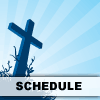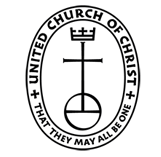Coming Around Again
Nov 29, 2009
Scripture: Luke 21: 25-36
“There will be signs in the sun, the moon, and the stars, and on the earth distress among nations confused by the roaring of the sea and the waves. People will faint from fear and foreboding of what is coming upon the world, for the powers of the heavens will be shaken. Then they will see ‘the Son of Man coming in a cloud’ with power and great glory. Now when these things begin to take place, stand up and raise your heads, because your redemption is drawing near.”
Then he told them a parable: “Look at the fig tree and all the trees; as soon as they sprout leaves you can see for yourselves and know that summer is already near. So also, when you see these things taking place, you know that the kingdom of God is near. Truly I tell you, this generation will not pass away until all things have taken place. Heaven and earth will pass away, but my words will not pass away. “Be on guard so that your hearts are not weighed down with dissipation and drunkenness and the worries of this life, and that day catch you unexpectedly, like a trap. For it will come upon all who live on the face of the whole earth. Be alert at all times, praying that you may have the strength to escape all these things that will take place, and to stand before the Son of Man.”
Sermon: Coming Around Again by Rev. Doreen Oughton
Look at this place. Isn’t it beautiful, all decorated for the holiday season. And it’s not only a new season, but it is a whole new liturgical year. Now in my home church, it is not the common practice to use the lectionary for preaching. For those of you unfamiliar with the term, the lectionary is a schedule of daily and weekly scripture readings recommended for Christian churches for study, reflection and preaching. The readings are on a 3-year cycle, so if a church follows the lectionary, it will preach on the same scripture around the same time every 3 years. But as I said, the church I came from did not generally follow the lectionary, but developed its own themes or topics. So when Advent came around, there might be a reading about the visit of the angel to Mary, or of Joseph’s dream telling him to stay with Mary, or essays and poems about waiting or hope. So I was pretty surprised at the gospel reading from today’s lectionary, this apocalyptic vision of fear and foreboding, of distress among nations, of the second coming of Christ. And my research says that each of the three years of the lectionary starts the season of Advent with a little apocalyptic vision.
It seems strange, doesn’t it, that at the time when we are waiting for the birth of Jesus, Luke’s gospel has a full-grown Jesus talking about the second coming. As we wait for the days to start lengthening once again, for increased light, Jesus tells us to watch for the days of darkness and distress. As one of the commentators on the lectionary noted: “who could possibly think that evoking these frightening images would be a good way to commence a journey toward Christmas. The whole thing seems like the spiteful act of a few grinch-like theologians bent on introducing cold air and smoke into our cozy holiday homes.” And these visions can be hard for us to identify with. Jesus quotes from Hebrew scripture the visions of the Son of Man coming in a cloud, he talks about heaven and earth passing away within that very generation. Sounds like the doomsday prophets on the street corners, with their predictions about the world ending on a certain date. It’s hard to take it seriously.
Of course there are people who can identify with these visions better than we can, at least on a personal level. People who are eager for the end of the world as they know it, eager for the day of judgment, when the world order is turned upside down. The people who are already living a catastrophe, as many of Luke’s audience were, as are people in war zones, in crime-infested areas, those sold into slavery, those who are oppressed and abused and exploited. Maybe these texts are meant to remind us that none of us are really free while some are oppressed. Maybe we are asked at the start of this season of waiting and hope to align ourselves with those who are in greater need of the coming of God’s kindom than we may be.
You know, even without the apocalyptic imagery, the idea of waiting anew every year for the birth of Jesus is so interesting to me. Because every year he is born, and we celebrate, and move into the next season of Epiphany. Christ is baptized and starts his ministry. Then every year comes the 40 days of Lent, with fasting and trials, and then the Passion, when we look closely at the sinfulness of humanity that kills our Savior. And then we celebrate the Resurrection and Eastertide and Pentecost, and all the promises that are made year after year after year. We go through Ordinary time, cap it off with our proclamation of Christ as King, and they we are around to waiting again for the hope to come, for the light to increase, as it already did last year, and the year before, and the year before that.
Now when I was working in addictions treatment, we would look at cycles like that and, as Jesus suggests in the scripture, identify patterns from which we could predict what would happen next. Jesus says look at the trees. We know their cycles of growth and loss, bloom and decay, you can predict what is going to happen by looking at what stage they are in. Now in the work I did, it was not a good thing to be stuck in a repetitive cycle. The pain and remorse one felt after acting out was just part of the cycle. The promises to do things differently and a period of “good” behavior, all just part of the cycle. Because by looking at the pattern, you could predict that the anxiety would increase, extra stress would trigger a period of acting out, followed by remorse, and promises and so on. Sometimes I wonder if the liturgical calendar somehow reflects a way that we get stuck in religion. Theologians talk about the “already-not yet” of salvation. Christ already came and redeemed us, but not fully. Promises have been kept, but there are those not yet fulfilled. Christ has been resurrected, but is yet to be born, again and again we cycle through it.
In my theology class we were assigned to small groups to explore more deeply some of the concepts covered in class. I was in a group with two Unitarian Universalists, and we were talking about the different theories of how Jesus saves. It was hard to argue with them when they noted that the world was hardly saved. There is still violence and war and exploitation and sin of many kinds. Christ’s sacrifice did not put an end to sin. Is all this talk of redemption and salvation just a point on the cycle, a way of deluding ourselves that this time things will be different? Are we just circling round and round, experiencing the same seasons of our lives, individually and collectively, over and over again?
I suppose for some this is true, just as for some the problems of this world can be seen as evidence that Jesus’ life did not make a difference. But not for me, and I hope not for you. Many of us might be able to identify with the idea of a breakthrough experience, something that changes our perspective and actions in a lasting way. We might cycle through certain issues, but we are different in how we face them. Spencer is a second born child. He will go through similar stages that his brother Anthony went through, but Alyson and Jeff are different. Instead of seeing the seasons of our lives as circular, we can understand them as spirals, upward spirals. So we can hear Jesus in today’s gospel reading cautioning us to read the signs, to recognize the frightening evidence of destruction in the world, from a breakthrough place. Even though Jesus used a cycle of nature, so familiar to his listeners, as a metaphor for recognizing patterns, he was introducing a whole new idea – that the world as they knew it would change. He was the breakthrough, and there were, and are, still more breakthroughs to come. We may not see him returning on a cloud, but we can experience him breaking through our lives at any moment, during any dark day of fear and foreboding. We still see the destruction around us, even within us, those parts of us that act from fear, from anger, from shame. But we can see it from a breakthrough place, opening ourselves anew to the promise and the hope. And in this breakthrough place, knowing that Jesus is born to us over and over again, as much as we need him to be, we spiral up to an understanding that we are not only receivers of the promise, but partners in fulfilling it. We are not only believers and witnesses to the hope, but bearers of it. As Jesus says, be alert at all times to the breakthroughs of the kindom, don’t let yourself get weighed down with dissipation and drunkenness and the worries of this life. God wants to enter your life and your heart over and over again. Can you stay ready for that? Can you let that spiral upward and outward so that we are not just waiting for the kindom, but creating it? May it be so.








